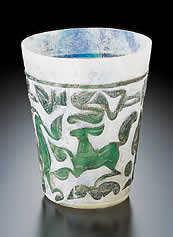|
planned to keep out the harsh rays of the sun, while
letting in light and wind. Skylights on ceilings brought in natural light
from above, and finely latticed shutters blocked heat, while letting in cool
breezes. Attention was given to every detail—stained glass covered lattices,
table legs were carved with openwork and inlaid with lamps, which glowed in
the evening, and cool fountains, surrounded by marble mosaics, adorned the
middle of large rooms.
 The craftsmanship of the water filters added another
touch of pleasure to this ornate environment. Water was valuable in the
intense heat of the Middle East, thus even its containers were given
significance. Water was filtered several times and stored in small, unglazed
jars, which were placed on windowsills to cool naturally by the latent heat
of vaporization. The craftsmanship of the water filters added another
touch of pleasure to this ornate environment. Water was valuable in the
intense heat of the Middle East, thus even its containers were given
significance. Water was filtered several times and stored in small, unglazed
jars, which were placed on windowsills to cool naturally by the latent heat
of vaporization.
 In this exhibition, 160 filters and fourteen Coptic
textiles from the renowned Collection Bouvier are shown in Japan for the
first time. The galleries are also arranged to give a sense of the early
lifestyle of a medieval Islamic city. Enjoy the exotic flavor of Egypt and
fill your senses with the exquisite motifs of the water filters, ceramic
ware, and textiles presented in this spring exhibition. In this exhibition, 160 filters and fourteen Coptic
textiles from the renowned Collection Bouvier are shown in Japan for the
first time. The galleries are also arranged to give a sense of the early
lifestyle of a medieval Islamic city. Enjoy the exotic flavor of Egypt and
fill your senses with the exquisite motifs of the water filters, ceramic
ware, and textiles presented in this spring exhibition.
|
 |











